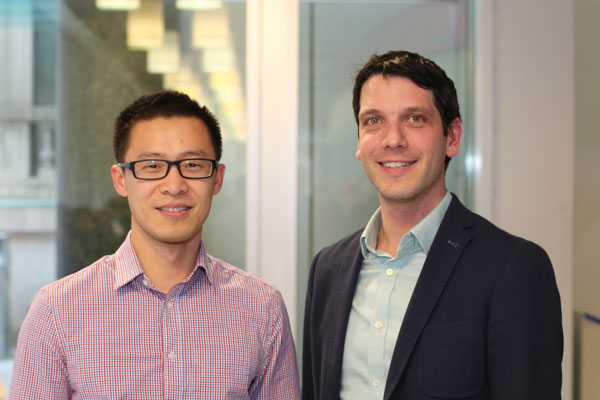U of T engineers Jason Chang (EngSci 0T4 + PEY + MBA) and Illan Kramer (ECE PhD 2013) build bridges, but not the traditional kind. They are the Faculty’s Directors of Corporate and Foundation Partnerships, responsible for strengthening relationships with the more than 300 companies that collaborate with U of T Engineering on sponsored research, educational initiatives and more.
Writer Tyler Irving recently sat down with Chang and Kramer to learn more about how industry and academia can work together.
What does industry partnership mean to you?
JC: We think of industry collaboration in a holistic way. Research is an important part of what we do, but we also involve industry in our educational programming. This can mean bringing forward project ideas for design or capstone courses, delivering guest lectures or participating on advisory boards. We also encourage companies to make philanthropic investments when they are a good fit with their mission and values.
IK: Partnering with the Faculty offers a number of benefits. On the research side, companies can collaborate with professors with world-leading expertise in fields that are relevant to their strategic priorities. In addition, by interacting with graduate or undergraduate students, they get access to a pipeline of new talent. Finally, they are creating goodwill and a name for themselves in their industry, which is always of benefit to a company.
How have industry partnerships evolved over the years?
JC: In the past, industry/academic collaborations often originated with a single enthusiastic individual — for example, a faculty member who had some existing relationship with a company. Today we aim to be more interdisciplinary. So instead of one professor, companies can now access an entire research network within the Faculty, which can examine issues from a variety of angles.
IK: Over the past 15 years, governments at various levels have created programs that encourage industry to participate by matching whatever contribution they make. If a company puts in a dollar, the government will put in another dollar or two to help fund that research. These programs provide enhanced incentives for industry to partner with academia and for academics to seek out industry partnerships.
Can you give an example of what a successful partnership looks like?
JC: One of our most recognizable and long-term industry partners is the engineering consulting firm Hatch Ltd. Hatch supports some specific research projects, but the company also encourages its employees to sit on advisory boards or deliver guest lectures. Hatch is involved with design courses at the undergraduate level and hires students for Professional Experience Year (PEY) internships. In addition, it provides philanthropic funding for capital projects at the university and for student scholarships. Hatch hires many of our students, and we’ve been told on many occasions that Hatch’s business has grown dramatically as a result of the interactions they have with the Faculty.
IK: IBM is another long-standing partner. In addition to the existing modes of interaction that Jason mentioned, IBM has been innovative in creating new types of collaborative relationships. For example, they created the Southern Ontario Smart Computing Innovation Platform (SOSCIP). SOSCIP allowed IBM to hire research staff who are based on campus at the university. As one of their first post-doctoral fellows, I got to use an IBM supercomputer to model new materials for making solar cells. I also got to work beside people studying entirely different problems — say climate modelling or biomedical research — but whose ideas could help cross-pollinate my work. IBM enabled a lot of research that would otherwise not have taken place.
Why are you personally passionate about this work?
JC: I studied both engineering and business at U of T, and I spent six years working in the mining industry. I saw that industry in Canada is a little bit behind in terms of technology development. We could have been interacting more with universities, and we weren’t. So when the Faculty said they were going to hire people to figure out how to improve these interactions, it was an opportunity that really resonated with me.
IK: When I was a graduate student and a post-doc here at U of T, I worked with some of the smartest and most talented people that I’ve ever met in my life. All of them loved living in Toronto, but as they graduated or finished their contracts and started looking for work, they felt like they had to go to Silicon Valley or Europe or China to find jobs commensurate with their skills and expertise. I wanted to find a way that we could keep some of them here.
It’s not about attracting the best and brightest from around the world; we’ve done that, they’re already here and they want to stay. We can be a big part of the solution by enhancing the ability of our local companies to grow and expand their research & development divisions, thereby creating capacity for these extremely talented people to contribute to a better society.




